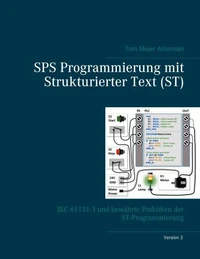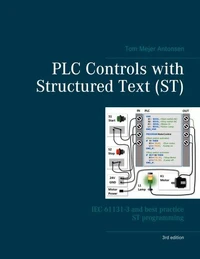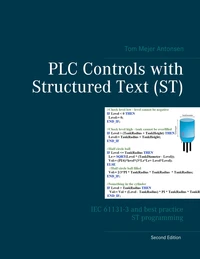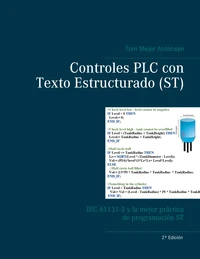PLC Controls with Structured Text (ST). IEC 61131-3 and best practice ST programming
Par :Formats :
Disponible dans votre compte client Decitre ou Furet du Nord dès validation de votre commande. Le format ePub protégé est :
- Compatible avec une lecture sur My Vivlio (smartphone, tablette, ordinateur)
- Compatible avec une lecture sur liseuses Vivlio
- Pour les liseuses autres que Vivlio, vous devez utiliser le logiciel Adobe Digital Edition. Non compatible avec la lecture sur les liseuses Kindle, Remarkable et Sony
- Non compatible avec un achat hors France métropolitaine
 , qui est-ce ?
, qui est-ce ?Notre partenaire de plateforme de lecture numérique où vous retrouverez l'ensemble de vos ebooks gratuitement
Pour en savoir plus sur nos ebooks, consultez notre aide en ligne ici
- Nombre de pages128
- FormatePub
- ISBN978-87-430-0637-4
- EAN9788743006374
- Date de parution02/07/2018
- Protection num.Adobe DRM
- Taille1 Mo
- Infos supplémentairesepub
- ÉditeurBooks on demand
Résumé
This book gives an introduction to Structured Text (ST), used in Programmable Logic Control (PLC)
The book can be used for all types of PLC brands including Siemens Structured Control Language (SCL) and Programmable Automation Controllers (PAC)
CONTENTS
- Background, advantage and challenge when ST programming
- Syntax and fundamental ST programming
- Widespread guide to reasonable naming of variables
- CTU, TOF, TON, CASE, STRUCT, ENUM, ARRAY, STRING
- Guide to split-up into program modules and functions
- More than 90 PLC code examples in black/white
- FIFO, RND, 3D ARRAY and digital filter
- Examples: From LADDER to ST programming
- Guide to solve programming exercises
Many clarifying explanations to the PLC code and focus on the fact that the reader should learn how to write a stable, robust, readable, structured and clear code are also included in the book.
Furthermore, the focus is that the reader will be able to write a PLC code, which does not require a specific PLC type and PLC code, which can be reused. The basis of the book is a material which is currently compiled with feedback from lecturers and students attending the AP Education in Automation Engineering at the local Dania Academy, "Erhvervsakademi Dania", Randers, Denmark. The material is thus currently updated so that it answers all the questions which the students typically ask through-out the period of studying. The author is Bachelor of Science in Electrical Engineering (B.
Sc. E. E.) and has 25 years of experience within specification, development, programming and supplying complex control solutions and supervision systems. The author is Assistant Professor and teaching PLC control systems at higher educations. LinkedIn: https://www.linkedin.com/in/tommejerantonsen/
Furthermore, the focus is that the reader will be able to write a PLC code, which does not require a specific PLC type and PLC code, which can be reused. The basis of the book is a material which is currently compiled with feedback from lecturers and students attending the AP Education in Automation Engineering at the local Dania Academy, "Erhvervsakademi Dania", Randers, Denmark. The material is thus currently updated so that it answers all the questions which the students typically ask through-out the period of studying. The author is Bachelor of Science in Electrical Engineering (B.
Sc. E. E.) and has 25 years of experience within specification, development, programming and supplying complex control solutions and supervision systems. The author is Assistant Professor and teaching PLC control systems at higher educations. LinkedIn: https://www.linkedin.com/in/tommejerantonsen/
This book gives an introduction to Structured Text (ST), used in Programmable Logic Control (PLC)
The book can be used for all types of PLC brands including Siemens Structured Control Language (SCL) and Programmable Automation Controllers (PAC)
CONTENTS
- Background, advantage and challenge when ST programming
- Syntax and fundamental ST programming
- Widespread guide to reasonable naming of variables
- CTU, TOF, TON, CASE, STRUCT, ENUM, ARRAY, STRING
- Guide to split-up into program modules and functions
- More than 90 PLC code examples in black/white
- FIFO, RND, 3D ARRAY and digital filter
- Examples: From LADDER to ST programming
- Guide to solve programming exercises
Many clarifying explanations to the PLC code and focus on the fact that the reader should learn how to write a stable, robust, readable, structured and clear code are also included in the book.
Furthermore, the focus is that the reader will be able to write a PLC code, which does not require a specific PLC type and PLC code, which can be reused. The basis of the book is a material which is currently compiled with feedback from lecturers and students attending the AP Education in Automation Engineering at the local Dania Academy, "Erhvervsakademi Dania", Randers, Denmark. The material is thus currently updated so that it answers all the questions which the students typically ask through-out the period of studying. The author is Bachelor of Science in Electrical Engineering (B.
Sc. E. E.) and has 25 years of experience within specification, development, programming and supplying complex control solutions and supervision systems. The author is Assistant Professor and teaching PLC control systems at higher educations. LinkedIn: https://www.linkedin.com/in/tommejerantonsen/
Furthermore, the focus is that the reader will be able to write a PLC code, which does not require a specific PLC type and PLC code, which can be reused. The basis of the book is a material which is currently compiled with feedback from lecturers and students attending the AP Education in Automation Engineering at the local Dania Academy, "Erhvervsakademi Dania", Randers, Denmark. The material is thus currently updated so that it answers all the questions which the students typically ask through-out the period of studying. The author is Bachelor of Science in Electrical Engineering (B.
Sc. E. E.) and has 25 years of experience within specification, development, programming and supplying complex control solutions and supervision systems. The author is Assistant Professor and teaching PLC control systems at higher educations. LinkedIn: https://www.linkedin.com/in/tommejerantonsen/














